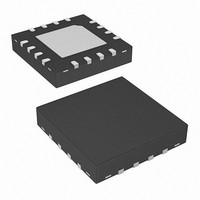ISL6269CRZ Intersil, ISL6269CRZ Datasheet - Page 8

ISL6269CRZ
Manufacturer Part Number
ISL6269CRZ
Description
IC CTRLR PWM 1-PHASE GPU 16-QFN
Manufacturer
Intersil
Datasheet
1.ISL6269CRZ.pdf
(14 pages)
Specifications of ISL6269CRZ
Pwm Type
Controller
Number Of Outputs
1
Frequency - Max
600kHz
Voltage - Supply
7 V ~ 25 V
Buck
Yes
Boost
No
Flyback
No
Inverting
No
Doubler
No
Divider
No
Cuk
No
Isolated
No
Operating Temperature
-10°C ~ 100°C
Package / Case
16-VQFN Exposed Pad, 16-HVQFN, 16-SQFN, 16-DHVQFN
Frequency-max
600kHz
Lead Free Status / RoHS Status
Lead free / RoHS Compliant
Duty Cycle
-
Available stocks
Company
Part Number
Manufacturer
Quantity
Price
Company:
Part Number:
ISL6269CRZ
Manufacturer:
INTERSIL
Quantity:
17
Part Number:
ISL6269CRZ
Manufacturer:
INTERSIL
Quantity:
20 000
Part Number:
ISL6269CRZ-T
Manufacturer:
INTERSIL
Quantity:
20 000
desired regulation voltage. When the EN pin is pulled above
the rising EN threshold voltage V
ramped above the rising POR
the PGOOD Soft-Start Delay t
begins to rise. The output voltage enters regulation in
approximately 1.5ms and the PGOOD pin goes to high
impedance once t
The PGOOD pin indicates when the converter is capable of
supplying regulated voltage. The PGOOD pin is an
undefined impedance if
POR threshold
threshold
identification capability that can drastically reduce trouble-
shooting time and effort. The pull-down resistance of the
PGOOD pin corresponds to the fault status of the controller.
During soft-start or if an undervoltage fault occurs, the
PGOOD pulldown resistance is 95Ω, or 30Ω for an
overcurrent fault, or 60Ω for an overvoltage fault.
MOSFET Gate-Drive Outputs LG and UG
The ISL6269 has internal gate-drivers for the high-side and
low-side N-Channel MOSFETs. The LG gate-driver is
optimized for low duty-cycle applications where the low-side
MOSFET conduction losses are dominant, requiring a low
r
order to clamp the gate of the MOSFET below the V
turnoff. The current transient through the gate at turnoff can
be considerable because the switching charge of a low
r
protection prevents a gate-driver output from turning on until
DS(ON)
DS(ON)
Soft Start or Undervoltage
VCC Below POR
TABLE 1. PGOOD PULL-DOWN RESISTANCE
CONDITION
MOSFET. The LG pulldown resistance is small in
MOSFET can be large. Adaptive shoot-through
Overvoltage
Overcurrent
V
VCC_THF
FIGURE 4. SOFT-START SEQUENCE
1.5ms
V
VCC_THR
SS
. The ISL6269 features a unique fault-
has elapsed.
V
, or if
VCC
PGOOD
2.75ms
VOUT
VCC
SS
EN
has not reached the rising
8
V
V
VCC_THR
VCC
ENTHR
starts and the output voltage
PGOOD RESISTANCE
is below the falling POR
and
Undefined
threshold voltage,
95Ω
60Ω
30Ω
V
VCC
has
GS(th)
at
ISL6269
the opposite gate-driver output has fallen below
approximately 1V. The dead-time shown in Figure 5 is
extended by the additional period that the falling gate voltage
stays above the 1V threshold. The high-side gate-driver
output voltage is measured across the UG and PHASE pins
while the low-side gate-driver output voltage is measured
across the LG and PGND pins. The power for the LG
gate-driver is sourced directly from the PVCC pin. The power
for the UG gate-driver is sourced from a “boot” capacitor
connected across the BOOT and PHASE pins. The boot
capacitor is charged from a 5V bias supply through a “boot
diode” each time the low-side MOSFET turns on, pulling the
PHASE pin low. The ISL6269 has an integrated boot diode
connected from the PVCC pin to the BOOT pin.
Diode Emulation
The ISL6269 normally operates in continuous-conduction-
mode (CCM), minimizing conduction losses by forcing the
low-side MOSFET to operate as a synchronous rectifier. An
improvement in light-load efficiency is achieved by allowing
the converter to operate in diode-emulation-mode (DEM),
where the low-side MOSFET behaves as a smart-diode,
forcing the device to block negative inductor current flow.
The ISL6269 can be configured to operate in DEM by setting
the FCCM pin low. Setting the FCCM pin high will disable
DEM.
Positive-going inductor current flows from either the source
of the high-side MOSFET, or the drain of the low-side
MOSFET. Negative-going inductor current usually flows into
the drain of the low-side MOSFET. When the low-side
MOSFET conducts positive inductor current, the phase
voltage will be negative with respect to the GND and PGND
pins. Conversely, when the low-side MOSFET conducts
negative inductor current, the phase voltage will be positive
with respect to the GND and PGND pins. Negative inductor
current occurs when the output load current is less than ½
the inductor ripple current. Sinking negative inductor current
through the low-side MOSFET lowers efficiency through
unnecessary conduction losses. Efficiency can be further
UG
LG
t
LGFUGR
FIGURE 5. LG AND UG DEAD-TIME
50%
50%
t
UGFLGR
June 25, 2009
FN9177.3












